
Mah-Jongg, The Cantonese Game
(Hong Kong Mah-Jongg)
Jeux
Mah-Jongg
(The Old Rule 13-Tile Game)
Mah jongg is a game of strategy, with one player's personality and behavior often affecting another player's chances of winning.
An inexperienced or careless player can inadvertently help an opponent to assemble a high-scoring hand. Mah jongg is also a game of luck.
Players believe strongly in Feng Shui, a belief that supernatural powers can bring good luck to a person occupying a particular seat at a certain time. For this reason, rightly or wrongly, players can become very finicky about where they sit.
Thus, it is not difficult to understand why seat
allocation is an important
part of the game.
Seat Allocation (Jup
Wai)
Once all four players are seated randomly around a square table,
any player may pick out four different Wind tiles and place them face down on
the table. After these Wind tiles have been thoroughly mixed, they are stacked
up one on top of another.

One player casts a set of two or three dice and the dots are summed. The dice caster counts him- or herself as 1, followed by the player at his or her right as 2, and thus the sequence of counting is carried out counterclockwise until the sum is reached.
The player who is the last one to be counted will pick up the top tile on the stack.
The player at his or her right picks up the next tile, the opposite player picks up the third, and the player at his or her left picks up the last tile. Whoever picks up the East Wind tile from the stack will have the prerogative of selecting the first seat.
The player with the South Wind tile will be seated at the right of the East Wind player and will be the East's Lower House.
The player with the West Wind tile will be seated opposite the East Wind player and will be the East's Opposite House. The last player, or the one with the North Wind tile, will be seated at the left of the East Wind player, and will be the East's Upper House.

For example, four players occupy seats A, B, C, and D as shown below.
The player at side A casts the dice and the total number of dots is 3 (or 7 or 11).
The player at side C should pick the top tile from the stack, the player at side D picks the second tile, the player at side A the third. The last tile belongs to the player at side B.
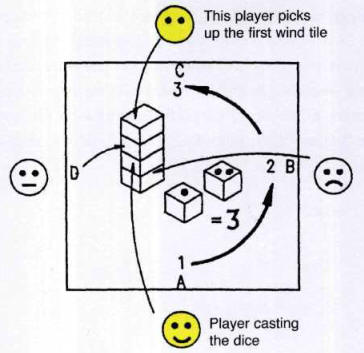
If the player with the East Wind tile chooses to sit at side A, then the players with the South Wind tile and the West Wind tile will be seated at side B and side C, respectively.
The player with the North Wind tile will be seated at side D.

Building the Walls (Darp Pai)
Once everyone is seated in his or her designated seat, all the players take part in turning the tiles face down and mixing them thoroughly.
Each player then forms a row of 17 tiles (18 if the Flower tiles are also used in the game), 2 tiles high and face down in front of him- or herself.

To add sophistication to the game when building the walls, each player first picks up 5 tiles with both hands (6 tiles if playing with the Flower tiles) to make the initial row of tiles. He or she then picks up 3 tiles in each hand and adds them separately to each end of the existing row.
The last step is repeated so that the final row consists of 17 tiles. After carefully aligning the tiles against the frame built around the mahjong table, the player makes another row of tiles in the same manner.
When this is done, he or she stacks the tiles and pushes the double-deck row toward the center of the table, joining the other rows as connecting walls. Some mahjong sets come with four rulers, each equivalent to the length of 18 tiles. The rulers are useful for gauging the length of the rows and keeping the walls of tiles straight and tidy.
Designating the First Dealer (Dar Jong)
There is a Dealer for each hand of the game. His or her function is to start the game and break the walls. In the ritual of choosing the First Dealer, the player who picked the East Wind tile during the seat allocation now casts two dice, and the dots are summed.
The same player begins to count counterclockwise, making him- or herself 1, the next player 2, and so forth until that sum is reached. The last player counted is named the First Dealer.
Example:
The player with the East Wind tile sitting at side A of the table casts the dice and the total number of the dots is five. The counting begins and ends at that player, making him or her the First Dealer.

Breaking the Walls (Hoi Pai)
The First Dealer commences the game. Starting at the right side of the wall of tiles he or she is facing, the Dealer counts the stacks clockwise according to the total number of dots on the dice cast, in this case five.
The First Dealer then separates the first five stacks from the rest of the wall, so as to mark the breaking point. From the breaking point, the First Dealer picks up 4 tiles from the first 2 stacks (the sixth and seventh stacks) from the walls.
He or she is followed by the Lower House, Opposite House, and Upper House. Each player proceeds to pick up two stacks at a time for three turns and a single tile at the fourth turn, thus ending with 13 tiles in his or her playing hand.
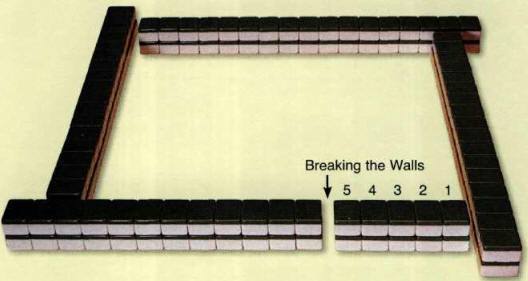

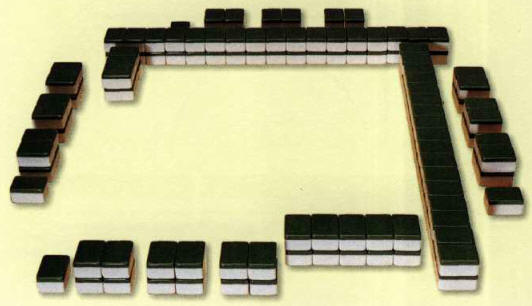
Leaping the Tiles (Til Pai)
Leaping the Tiles (Til Pai) A little ritual is usually performed by the Dealer after he or she picks up the 12th tile.
The Dealer does not have to wait until all three players have picked up their 13th tile to make the first draw.
He or she can start the exchange process by picking up a 14th tile from the wall at the same time the 13th tile is picked up (leaping over), to save a little time and to add some sophistication to the game.

Each player now has 13 tiles (the Dealer has 14 if the leap was included), which he or she arranges in a row facing him- or herself. Beginners benefit by placing all the matched tiles on the left side and all the unmatched tiles on the right.
By doing so, a player can easily identify what is in the hand and thus avoid accidentally discarding a matching tile. As a courtesy, players always play with their right hands.

Matching the Tiles (Jo Pai)
The tiles are matched in an exchange process.
The exchange process begins with the Dealer, who discards the first tile from his or her hand of 14. Moving counterclockwise, each player takes a turn drawing a tile from the remaining walls and discarding the least desirable tile from his or her hand.
The least desirable tile could well be the one just drawn from the walls. Alternatively, instead of drawing a tile from the walls, a player can claim a tile discarded by another player, that will go toward making a matched set. Thus, a matched set can be assembled by using only the tiles in the playing hand or by claiming a tile discarded by another player.
In any case, by retrieving a tile to replace the one immediately discarded, each player always keeps 13 tiles in his playing hand. Through this exchange process, the players try to rid themselves of their undesirable tiles in order to put together a winning hand. The same procedure is continued until one player matches all of the tiles in his or her hand.
In some Chinese mah jongg games, not all the tiles on the remaining walls are available for drawing.
In the Cantonese Game, there will always be 14 tiles that are untouchable at the tail ends of the walls. In the 16-Tile Game, the number of untouchable tiles is 16. But in the Shanghai Game, every single tile is available for drawing.

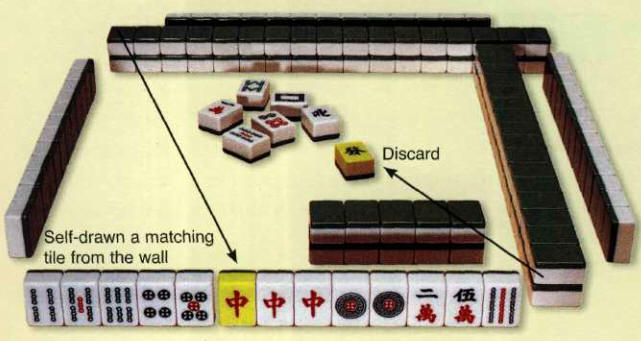
Claiming a Discarded Tile
Sheung - To Match a Sequence


Pung - To Match a Triplet
When a player holds a pair of identical tiles, he or she may claim a third matching tile when it is discarded by any of the other three players by declaring Pung.
By doing so, he or she picks up the discarded tile, adding it to the two matching tiles, and displays the Triplet face up on the table. The player then discards a tile and the person on the right (his or her Lower House) continues the game as usual.
Because the player who declares Pung has higher priority over any player who declares Sheung, he must declare Pung as soon as the matching tile is discarded on the table and before the Lower House of the discarder has had a chance to declare Sheung.
A player who fails to declare Pung cannot claim the same tile discarded by other players until after he or she has made a discard. Of course, all the players must keep track of the recent discards.
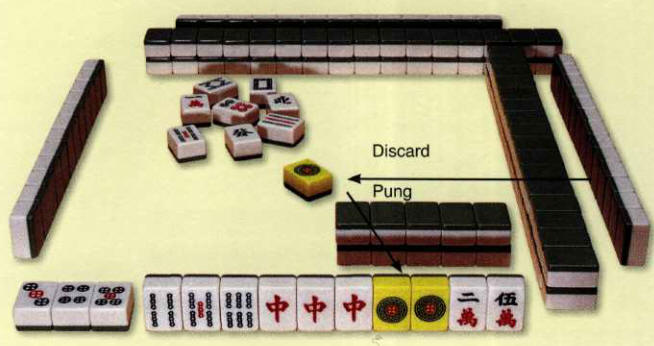
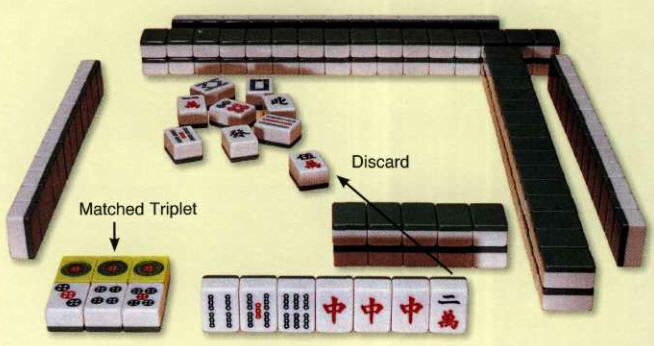
Revealed and Concealed Sets
When a tile that completes a set is taken from a discard, the matched set must be displayed face up on the table. This is called a revealed set.
When a matched set is formed in the first 13 tiles drawn from the wall or is formed with a tile drawn from the wall by the player, the matched set is kept in the hand, unrevealed to the other players. The set is called a concealed set.

Gong - To Match a Quadruplet
A. Drawing the fourth identical tile


When a player who has a revealed or concealed Triplet draws the fourth identical tile from the wall, he or she has the option of keeping it to match an already-held concealed Sequence or to declare Gong.
By declaring Gong, the player adds the drawn tile to the revealed or concealed Triplet and displays the Quadruplet on the table.
B. Claiming the fourth identical tile
It is only when a player has a concealed Triplet that he or she can declare Gong and claim the fourth identical tile discarded by any player. But the Quadruplet must be revealed on the table afterward.

Remember, each time a player declares Gong and adds the fourth identical tile to a Triplet, he or she must immediately draw a makeup tile from the end of the wall and discard a tile.
The game is continued by the player's Lower House (Bo Pai).

Revealed Gong (Ming Gong)
Declaring Gong by adding the self-drawn fourth identical tile to a revealed Triplet.
Concealed Gong (Um Gong)
Declaring Gong by adding the self-drawn or claimed fourth identical tile to a concealed Triplet.
The purposes of declaring Gong are
(1) to disrupt the other players' turn in order to draw a tile from the wall,
(2) to prevent other players from claiming the tile,
(3) to gain an extra chance to draw a tile, and
(4) to gain an additional Fan for a winning hand.
Priority in Claiming Discards
First Priority: To match the last set of the tiles in a winning hand by declaring Sik, one can claim the winning tile discarded by any other player.
Second Priority: To match a Triplet by declaring Pung, or to match a Quadruplet by declaring Gong, one can claim the discard from any other player.
Third Priority: To match a Sequence by declaring Sheung, one can claim the discard only from his or her Upper House (that is, the player to the left).
Example:
You have the No. 4 and No. 5 Circle tiles in your playing hand. You are ready to claim the No. 3 Circle tile discarded by your Upper House, to form a Sequence of Nos. 3, 4, and 5.
If, however, your Lower or Opposite House is holding a pair of No. 3 Circle Tiles, he or she has higher priority to claim the discard to match a Triplet.
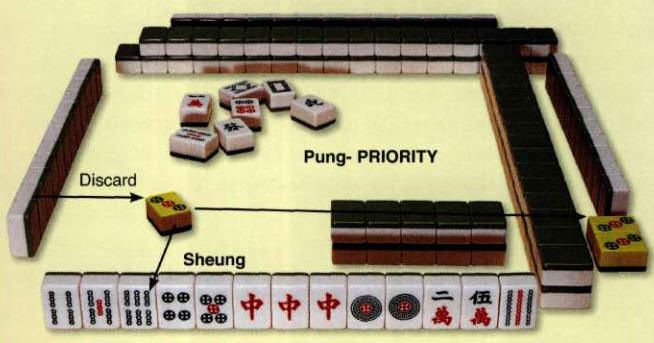
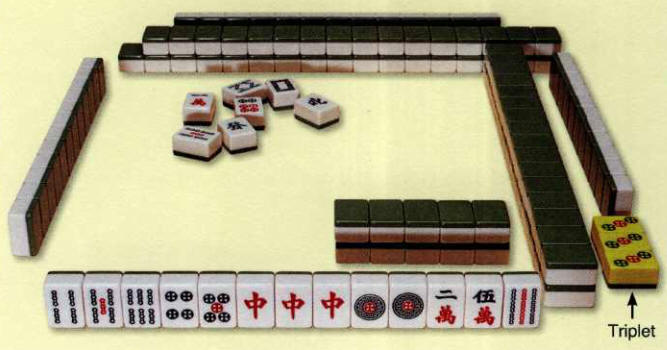
When to Declare a Win (Ting Pai)
Since a winning hand consists of 14 tiles (except when a hand consists of one or more Quadruplets, each of which has an extra tile), when a player matches all the 13 tiles in his or her hand, only one final matching tile is needed to complete the hand.
The 13 matched tiles are called a Ready Hand, and the holder of a Ready Hand is called a Calling Player. The final matching tile is called the Winning Tile.
A Calling Player can complete a hand by drawing the Winning Tile from the walls during his or her turn, or by claiming the Winning Tile when another player discards a tile or declares a revealed Gong.
Note that if a player fails to claim the Winning Tile when it is first discarded by a player, he or she cannot claim the Winning Tile discarded by other players until after making his or her own discard.
The player can declare a win, however, if the same Winning Tile is self-drawn. In the 16-Tile Game, a self-drawn tile is treated just like a discarded tile in this situation.

When a player declares a Win, or Sik, he or she must first turn all of his or her tiles face up on the table and then add the Winning Tile to the hand, so as to allow the other players to examine the hand, and to calculate the score.
But if the Winning Tile is self-drawn, the winner must first reveal the self-drawn tile before turning all the tiles face up on the table.
When two or more players declare a win by claiming the same discarded tile, the Lower House of the discarder has first priority, while the Upper House has lowest priority.
There is only one exception to this: when the holder of a 13 Terminal Tile Hand claims the discarded tile to complete a winning hand, he or she can declare a win regardless of his or her position relative to the tile-discarding player.
Also, there can be more than one winner if the players have agreed to such a rule before starting the game. A player must always know what his or her Winning Tiles are, in order to declare a win whenever one presents itself.
A player must be careful not to declare a false win, however, or he or she will be subject to a penalty, which can upset the other players. After each hand, the tiles are turned face down, mixed well, and the walls are built again, ready for the next hand.
Failing to Claim a Discard to Declare Pung or a Win
If a player fails to claim a discard to declare Pung, he or she is not permitted to claim the same tile subsequently discarded by the next players until after making his or her own discard.
If a player fails to claim a discard to declare a win, he or she is not permitted to claim the same tile or another Winning Tile subsequently discarded by the next players until after he or she has made a discard.
In the Cantonese Game, the Shanghai Game, and the 12-Tile Game, however, the player is permitted to declare a win if he or she subsequently draws the Winning Tile, even before making a discard. But in the 16-Tile Game, a self-drawn tile is treated like a discarded tile in this situation.
Example:
You have a No. 2 and No. 3 but fail to claim a No. 1 to declare a win, you cannot claim a No. 1 tile or a No. 4 tile subsequently discarded by the next players until after you have made a discard yourself.
In the Taiwanese Game, if a player misses a chance to claim a discard to declare a win, or discards a Winning Tile by mistake, he or she is not permitted to declare a win by claiming the same tile until making a discard, regardless of whether that same tile is a subsequent discard or a self-drawn tile.
The Dealer and the Duration of a Game Each hand of the game always has a Dealer. The Dealer will keep the role until another player wins a hand. In such a case, the dealership is passed on to the Dealer's Lower House.
When each player has been Dealer at least once and the fourth Dealer loses the hand, a round of the game is completed.
The game will continue in the second round with the first- term Dealer announcing the Wind of the new round. The first round of the game is called the East Round, which is followed by the South Round, the West Round, and the North Round. The game is completed when the last Dealer in the North Round loses his or her hand in the fourth round.
A complete game consists of four rounds.
Players may continue the game by starting another four rounds. But the seat allocation procedure and the designation of First Dealer are usually determined all over again.
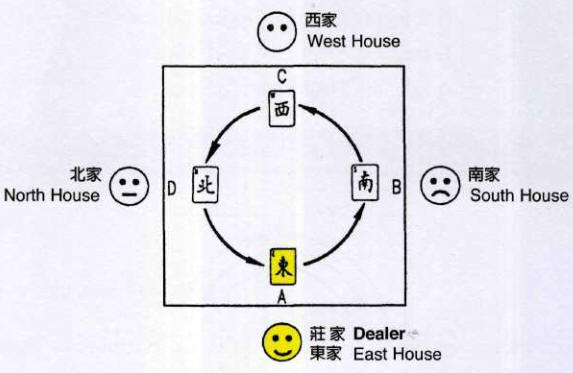
The Dealer of each game is called the East House.
Other players will have corresponding titles. The Dealer's Lower House is the South House, the Dealer's Opposite House is the West House, and the Dealer's Upper House is the North House.
During the game, a Round Indicator (Jong), which shows the proper round, is passed to a new Dealer located to his or her right.
The Dealer commences each game by casting the dice to decide which one of the walls is to be broken and which stack of tiles is to be the first stack to be picked up.
Example:
The Dealer is seated at side A of the table and casts two dice.

If the Dealer is seated at side A of the table and the sum of dots is three, the Dealer picks up stacks No. 4 and No. 5 of wall G.
This is followed by the Dealer's Lower House, Opposite House, Upper House, then the Dealer again, and so on. Each takes a turn to pick up two stacks of tiles in the clockwise direction for three turns and one tile in the last turn.

Scoring (Gai Fan)
The score is counted in terms of Fan. A certain number of Fans is given to a certain combination of matched sets in a hand. An easy combination of matched sets has a lower score than a difficult one.
Great variation exists in the combinations of matched sets. The players can choose to limit the type of combinations to be scored, however, and to set the minimum and maximum number of Fans for a winning hand.
The following are the most common choices of combinations, with their corresponding scores in the Cantonese Game (Old Rules).

ONE FAN
1A Ping Woo - Common Hand
The Common Hand consists only of Sequences in more than one suit.

IB Fan Jee Dragon
Tiles Each Triplet of Dragon tiles earns the winner a Fan. The exception is the presence of more than two Triplets of Dragon tiles in a winning hand (see 3C and 6A).


1C Huen Fung Wind of the Round
A Triplet of Wind tiles that matches the round of the game is worth a Fan. Huen Fung means a Triplet of East Wind tiles in the East Round (the first round), a Triplet of South Wind tiles in the South Round (the second round), a Triplet of West Wind tiles in the West Round (the third round), or a Triplet of North Wind tiles in the North Round (the fourth round).

ID Moon Fung - House Wind Tiles
A Triplet of Wind tiles that matches the player's position in a round earns the winner a Fan. Moon Fung means a Triplet of East Wind tiles for the Dealer, a Triplet of South Wind tiles for the Dealer's Lower House, a Triplet of West Wind tiles for the Dealer's Opposite House, or a Triplet of North Wind tiles for the Dealer's Upper House.
IE Chi Mo - Self-drawn
When the winner draws the winning tile from the wall, he earns an extra Fan by Chi Mo.
IF Cheung Gong - Robbing a Gong
When the winner claims the winning tile (the fourth identical tile) from another player who has just declared a revealed Gong, he earns an extra Fan by Cheung Gong.
1G Moon Ching - All Concealed Hand
(Note: Moon Ching is not included in the original Old Rules Game. This scoring hand is optional.) When the winning hand is without any revealed set, the player earns an extra Fan for "keeping his door clean."
1H Dok Ting - Single Way to Win
(Note: Dok Ting is not included in the original Old Rules Game. This scoring hand is optional.)
When the player has only one chance to match the winning set or the Eyes, he or she can earn an extra Fan. For example, when the last set to match in making a winning hand consists of a No. 1 tile and a No. 2 tile, then the only way to win is to obtain a No. 3 tile.
The player cannot win the game in any other way. Similarly, if the last set to match contains a No. 4 tile and a No. 6 tile, the only way to win is to obtain a No. 5 tile. Waiting for a tile to complete the Eyes is known as the Dok Ting situation.

II Far Yiu - Terminal Triplets with Honor Tiles
When a winning hand is a mixture of Terminal Triplets of the Common tiles and one or more Triplets of the Honor tiles, and the Eyes are also a pair of Honor tiles or Terminal tiles, the hand is called Far Yiu. The winner then earns an extra Fan.

TWO FANS
2A Gong Sheung Far - Added Glory to a Gong
The Winning Tile is the make-up tile following a revealed or concealed Gong.
2B Hoi Day - The Last Tile
The Winning Tile is the last drawable tile or the last discard. (Note: The last 14 tiles on the tail end of the walls are not drawable.)
2C Huen Moon Fung - Prevailing Wind Tiles
A winning hand containing a Triplet of Wind tiles when the Wind matches both the player's seating position (see ID Moon Fung) and the Wind of the round (see 1C Huen Fung).
For example, the Dealer has a winning hand containing a Triplet of East Wind tiles in the East Wind Round.
THREE FANS
3A Dui Dui Woo - All Triplets
A winning hand consisting of only Triplets and Eyes.

3B Won Yat Sik - Mixed One Suit
A winning hand consisting of sets from one suit of the Common tiles mixed with Honor tiles.

3C Siu Sam Yuen -Junior 3 Chiefs
A winning hand consisting of two Triplets plus one pair of Dragon tiles.

3D Gong Sheung Gong Double Gong
When a player draws or claims a fourth tile to declare a Gong and form a Quadruplet, he or she must draw a make-up tile from the end of the wall. If the make-up tile is the fourth tile of another Triplet, the player declares Gong again and draws another make-up tile from the end of the wall.
If the second make-up tile happens to be the Winning Tile of the hand, the situation is called Double Gong. Any winning hand with a Double Gong earns the winner an additional 3 Fans.
3E Hoi Day Lao Yuet - Catching the Moon from the Bottom of the Sea
The self-drawn Winning Tile is the last drawable tile of the wall, which is a No. 1 Circle tile that forms the Eyes with another No. 1 Circle tile in the winning hand. Remember, there are 14 untouchable tiles on the tail ends of the walls.
3F Gong Sheung Mui Far Plum Blossom on a Gong
The Winning Tile is a No. 5 Circle tile, which is the make-up tile self- drawn after a Gong. It forms a Sequence with a No. 4 Circle tile and a No. 6 Circle tile.

SIX FANS
6A Dai Sam Yuen Grand 3 Chiefs
A winning hand containing three Triplets of Dragon tiles.

6B Siu Sei Hei Junior 4 Happiness
A winning hand containing three Triplets and a pair of Eyes, all composed of Wind tiles.

6C Ching Yat Sik - Pure One Suit
A winning hand consisting solely of Common tiles in any one suit.

6D Eight Flower Tiles
If during the game, a player draws all eight flower tiles, he or she will have a winning hand.

EIGHT FANS 8A Dai Sei Hei - Grand 4 Happiness
A winning hand containing all four Triplets of the Wind tiles.

8B Chuen Tse - All Honor Tiles
A winning hand containing four Triplets and the Eyes, all composed of Honor tiles.

8C Kan Kan Woo - All Concealed Triplets
A winning hand containing four concealed Triplets and the winning tile is self-drawn. (Note: A Quadruplet is not counted as a concealed Triplet in this case.)
8D Sup Sam Yiu 13 Terminal Tiles
A winning hand containing one of No. 1 and No. 9 tiles of all three Common suits and one of all the Honor tiles, plus any one matching tile for the Eyes.

8E Tin Woo - Heavenly Hand
When the Dealer draws the first tile from the wall and this first tile is a winning tile, he or she has a Heavenly Hand.
8F Dei Woo - Earthly Hand
When the winning tile is claimed from the first discarded tile by the Dealer, the winner has an Earthly Hand.
Computing the Fans
Fans are summed by all possible scoring combinations in a winning hand.

Example 1: An All Triplet Hand containing a Dragon Triplet earns 4 Fans.


Example 2: A Mixed
One-Suit Hand with two Dragon Triplets earns 5 Fans.


Example 3: A winning
hand with all Triplets, mixing one suit and two Dragon Triplets, earns 8 Fans.


Example 4: A winning hand with all Triplets, mixing one suit and Junior 3 Chiefs, earns 9 Fans.


Example 5: A winning hand with four Sequences and the Eyes all in one suit earns 7 Fans.

Example 6: A winning hand with all Triplets and the Eyes in one suit earns 9 Fans.


Example 7: A mixed One Suit, All Triplet Hand with Grand 3 Chiefs (all three Dragon Triplets) and a self-drawn Winning Tile earns 13 Fans.
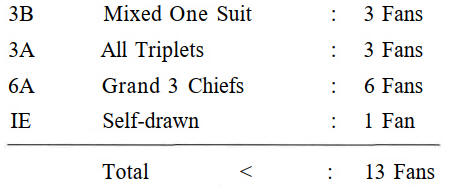
Awarding the Winner
When playing the Cantonese Game, the rule of choosing awards must be agreed upon by all the players prior to the game. There will be only one winner in each hand of the game.
If there is more than one player claiming the same discarded tile to complete the winning hand, then the Lower House of the discarder has higher priority than the other players. The Upper House has the lowest priority.
Jit Woo - To Intercept a Winning
Hand Stealing the winning chance from the players with lower priority by interception is called Jit Woo. This happens quite often when two players claim the same discarded tile to complete winning hands.
Sometimes the player with lower priority has a much higher-scoring hand than that of the interceptor. This unfortunate paradox can be upsetting for the higher- scoring player.
In the Cantonese Game, the method of determining the winner's awards is intended to motivate the players to reach the highest possible score.
The formula for awards enables the winner to double his or her award for each additional Fan when the total score is four Fans or less, and for every two additional Fans for five Fans or higher. The award is given in points. A point can be of any value agreed upon by the players prior to the game.
Table of Awards

4-Fans is called Moon Woo (Full Woo)
6-Fans is called Seung Lart (Double Hot)
8-Fans is called Sam Lart (Triple Hot)
10-Fans is called Sei Lart (Quadruple Hot)
12-Fans is called Ung Lart (Quintuple Hot)
Paying the Winner
Of course, as with any game, the winner should be rewarded. But who should pay the winner or winners? And how much? The players can choose one of the following ways to pay the winner:
(1) Only the discarder pays the winner one full score.
(2) Only the discarder pays the winner two times the full score.
(3) The discarder pays the winner the full score, and each of the other two players pays the winner one-half of the full score.
(4) In the event of (1) or (2), when a player claims the fourth identical tile discarded by another player to declare a Concealed Gong, and the make-up tile is the Winning Tile of his or her winning hand, then the discarder of the fourth identical tile pays the winner three times the full score.
If the Winning Tile is self-drawn, the other three players each pay the winner one full score.
Bao - Penalty to the Risk Taker
Under each of the following situations, the discarder of the Winning Tile must pay the winner a total of two times the full score, for him- or herself and the other two players:
Bao Fan Jee
(a) Grand 3 Chiefs Hand: One player has revealed two sets of Dragon Triplets and another player (the risk taker) discards the third Dragon tile, which turns out to be the Winning Tile of a Grand 3 Chiefs Hand.
b) Grand 4 Happiness Hand: One player has revealed three sets of Wind Triplets and the risk taker discards the fourth Wind tile, which turns out to be the Winning Tile of a Grand 4 Happiness Hand.
(c) All Honor Tiles Hand: One player has revealed three sets of Honor tiles (in combination with Wind and Dragon tiles), and the risk taker discards any Honor tile, which turns out to be the Winning Tile of an All Honor Tiles Hand
Bao Tiu Kau
(d) All Terminal Triplets Hand: One player has revealed three sets of Terminal Triplets, and the risk taker discards any Terminal tile, which turns out to be the Winning Tile of an All Terminal Triplets Hand.
Bao Kaujeung
(e) Pure One-Suit Hand: One player has revealed three sets of tiles of the same suit and the risk taker discards a tile of the same suit, which turns out to be the Winning Tile of a Pure One-Suit Hand.
The following situations are also involved with risk taking, but the penalty is different:
Bao Sup Yeejeung
(f) Same as the situations in (c), (d), or (e), but the discarded tile is not the Winning Tile. Instead, the discarded tile made by the risk taker is a matching tile of the fourth set in the same suit.
The situation then becomes more complicated:
A. If the player with four revealed sets draws the Winning Tile, then the risk taker must pay the winner for all the other players as well as for him- or herself. This will amount to three times the full score.
B. If the player with four revealed sets subsequently claims the Winning Tile from another discarded by the risk taker, the risk taker must pay the winner for all the other players as well as for him- or herself. This will amount to only two times the full score.
C. If the player with four revealed sets subsequently claims the Winning Tile from a discard by a third player (that is, not the risk taker), then both the risk taker and the third player must pay the winner one full score each.
Bao Sangjeung
(g) When there are only five drawable tiles remaining on the table, and a player discards a Winning Tile that has not been discarded or revealed earlier, the discarder must pay the winner for all the other players as well as for him or her self.
Bao Sin Ung Bao Hau
(h) If two players have each revealed three sets of tiles in one suit
(for example, Player A reveals three sets of Circle tiles and, later, Player B reveals three sets of Bamboo tiles), and it happens that Player C has only Circle and Bamboo tiles remaining in his or her playing hand, Player C will not be penalized in payment for all the other players even if he discards the winning tile to Player B.
This holds true if Player C has not claimed any discards after Players A and B have each revealed three sets of tiles of the same suit. But Player C will be penalized if he or she discards the Winning Tile to Player A.
Penalties
Falsely Declaring a Win (Jar
Woo)
If a player declares a win by claiming a discarded tile or by
drawing a tile, and it turns out that his hand is not yet ready for the win,
then the win has been falsely declared. In this case, he or she must pay each of
the other three players an amount equivalent to four Fans.
Long or
Short Hand (Dai Sheong Kung, Siu Sheong Kung)
If, during a game, a
player finds that his or her playing hand is either more, or less, than 13
tiles, the player is not allowed to discard the excessive tile or to draw a
make-up tile to complete the hand. Instead, he or she must continue to play by
drawing and discarding tiles as usual until the game is over.
This player must be careful in discarding tiles. To avoid losing to a high-scoring hand, he or she should discard only nonmatching tiles to other players, in the hope that no opponent will win the game by claiming one of the discards.
Fortune Hand - a Draw (Wong Pai)
When only seven stacks (14 tiles) are left on the wall, with none of the players being able to complete a winning hand, the game is considered a draw. This is called a Fortune Hand because there is no loser. The same Dealer will continue for the next game.
Playing with Flower Tiles (Dar Far)
In addition to the 136 basic tiles, a set of mahjongg also contains 8 Flower Tiles, comprising two sets of 4 tiles. The 4 tiles in one set represent the four seasons, while the 4 tiles in the other set represent the blossoms or plants of the 4 seasons.
| Set One | Set Two |
 No. 1: Spring No. 2: Summer No. 3: Autumn No. 4: Winter |
 No. 1: Plum No. 2: Orchid No. 3: Chrysanthemum No. 4: Bamboo |
Playing with the Flower tiles is optional. Flower tiles score additional Fans
for the winning hand.
When building the walls, the Flower tiles are mixed
with the other tiles. Each player will then stack up a row of 18 pairs of tiles
instead of 17 pairs. A playing hand still contains 13 tiles, however.
After the initial 13 tiles are drawn from the walls, each player reveals all the Flower tiles contained in the initial selection by placing them face up on the table.
Then the exchange process begins. Starting with the Dealer, each player in turn draws a make-up tile from the end of the wall for each revealed Flower tile.
If the make-up tile happens to be another Flower tile, the player immediately draws another make-up tile from the end of the wall. (In the 16-Tile Game, the player must wait until all the other players have drawn their make-up tiles in their normal turns.)
Similarly, during the course of the game, when a player draws a Flower tile from the wall, he or she reveals it and immediately draws a make-up tile from the end of the wall.
At no time is a Flower tile allowed to be kept in a playing hand. Moreover, if the player forgets to draw a make-up tile to replace the revealed Flower tile, he or she is not permitted to draw a make-up tile after a discard has been made.
In that case, the hand will be a tile short, known as a Short Hand (see Section above). The player is therefore unable to complete his or her hand to win the game.
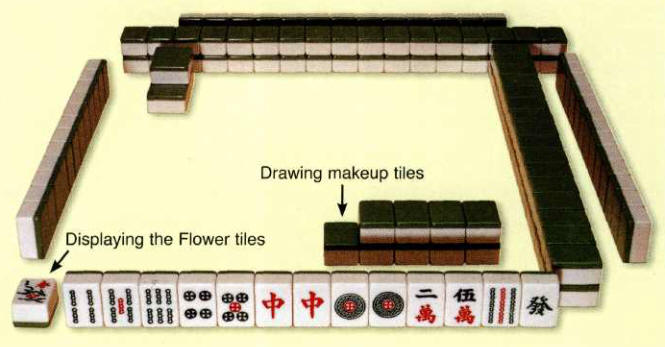
Scoring for Flower
Tiles Each Flower tile adds a Fan to the winning hand. Nevertheless, the players should agree upon the method of counting Fans and scoring prior to starting the game.
The following are the common methods of scoring Flower tiles:
A. The possession of each Flower tile, or the absence of Flower tiles, is counted as one Fan.
B. The possession of any of the Flower tiles that matches the round of game is counted as one Fan. Flower tiles that match the round of the game:
No. 1: Flower tiles during the first round (East Round).
No. 2: Flower tiles during the second round (South Round).
No. 3: Flower tiles during the third round (West Round).
No. 4: Flower tiles during the fourth round (North Round).
C. The possession of any of the Flower tiles that matches the respective position of the player is counted as one Fan. Flower tiles that match the respective position of the players:
No. 1: Flower tiles in the hand of the Dealer.
No. 2: Flower tiles in the hand of the Dealer's Lower House.
No. 3: Flower tiles in the hand of the Dealer's Opposite House.
No. 4: Flower tiles in the hand of the Dealer's Upper House.
D. The possession of any of the Flower tiles that matches both the round of the game and the respective position of the players is counted as two Fans.
No. 1: Flower tiles in the hand of the Dealer during the first round,
No. 2: Flower tiles in the hand of the Dealer's Lower House (the South House) during the second round of the game, and so on.
Any player who accumulates all eight Flower tiles during the game, is considered to have completed his or her hand and thus wins the game.
Note: When a player has accumulated seven Flower tiles, he or she can claim the eighth Flower tile previously or subsequently drawn from the walls from any player to win the game. The drawer of the eighth Flower tile is considered the discarder of the Winning Tile.
Five-Player Game - Dreaming (Dar Mung)
Mah jongg is normally a four-player game, but five players can play it by rotation. During the allotment of seats at the beginning of the game, a No. 5 Circle tile is added to the four Wind tiles to make a five-tile stack.
The four players who pick the Wind tiles will start the game.
The person who picks the No. 5 Circle tile must wait an entire round before he or she can participate. Since the fifth player has little to do, he or she is aptly called a Dreamer.
At the end of the first round (East Wind Round), the First Dealer retires and is replaced by the fifth player, the Dreamer. The retired First Dealer becomes a Dreamer for the second round.
At the end of this round (South Wind Round), the South player is replaced by the First Dealer. The game continues until five rounds have been reached, with each player having participated in four of the five. If desired, the game can continue uninterrupted by repeating the same procedure.
The seat reallotment is not required after each five-round cycle.
Three-Player Game (Dar Sam Yan Pai)
The game can be played as well in the absence of one player, by removing any one suit of the tiles from the set.
However, when casting the dice to designate the First Dealer and to break the walls in each game, if the count ends at the absentee player, the dice must be cast again.
